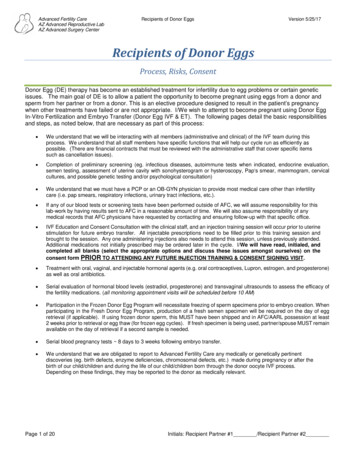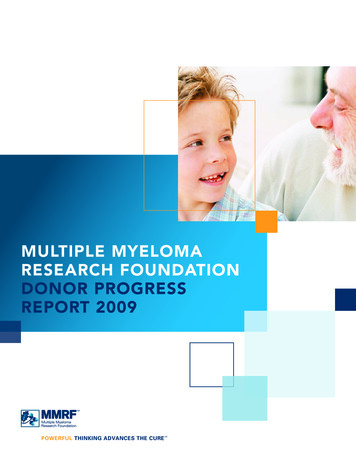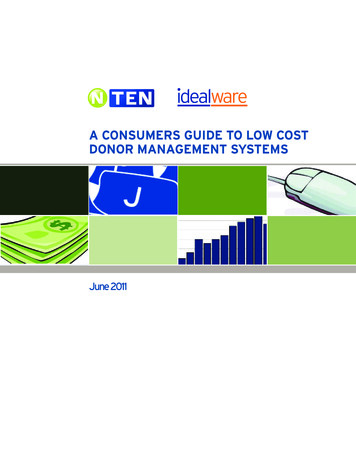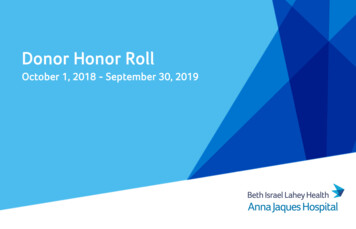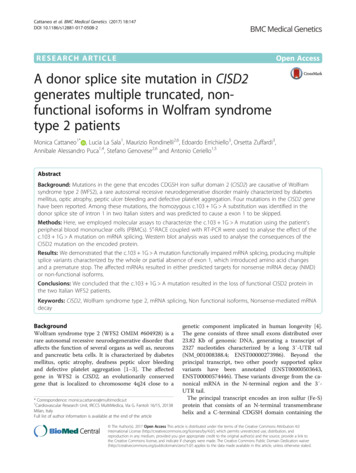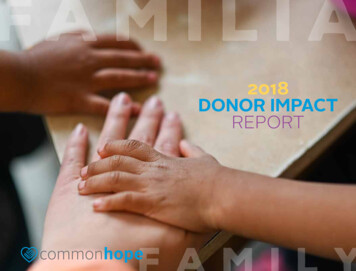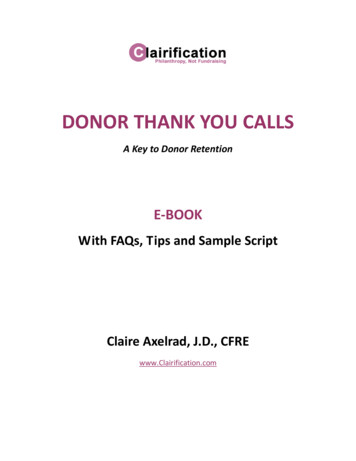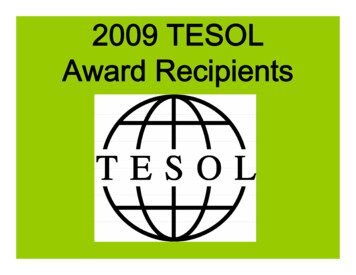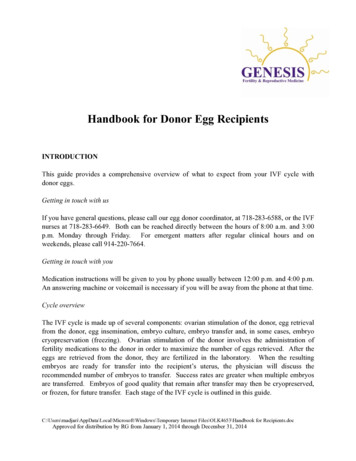
Transcription
!!!Handbook for Donor Egg Recipients!INTRODUCTION!This guide provides a comprehensive overview of what to expect from your IVF cycle withdonor eggs.!Getting in touch with us!If you have general questions, please call our egg donor coordinator, at 718-283-6588, or the IVFnurses at 718-283-6649. Both can be reached directly between the hours of 8:00 a.m. and 3:00p.m. Monday through Friday. For emergent matters after regular clinical hours and onweekends, please call 914-220-7664.!Getting in touch with you!Medication instructions will be given to you by phone usually between 12:00 p.m. and 4:00 p.m.An answering machine or voicemail is necessary if you will be away from the phone at that time.!Cycle overview!The IVF cycle is made up of several components: ovarian stimulation of the donor, egg retrievalfrom the donor, egg insemination, embryo culture, embryo transfer and, in some cases, embryocryopreservation (freezing). Ovarian stimulation of the donor involves the administration offertility medications to the donor in order to maximize the number of eggs retrieved. After theeggs are retrieved from the donor, they are fertilized in the laboratory. When the resultingembryos are ready for transfer into the recipient’s uterus, the physician will discuss therecommended number of embryos to transfer. Success rates are greater when multiple embryosare transferred. Embryos of good quality that remain after transfer may then be cryopreserved,or frozen, for future transfer. Each stage of the IVF cycle is outlined in this Windows\Temporary Internet Files\OLK4653\Handbook for Recipients.docApproved for distribution by RG from January 1, 2014 through December 31, 2014
!!!!PRIOR TO CYCLING!1. Medical history, physical exam and uterine sounding!A complete history and physical examination of the recipient is necessary prior to beginningtreatment. Our program physician will perform the physical exam and uterine sounding. Duringthe uterine sounding, the physician passes a slender tube (catheter) through the cervix and intothe uterus to determine its depth and curvature. The procedure is usually no more uncomfortablethan a pap smear. It facilitates the actual embryo transfer by creating a “roadmap” so that thetransfer can proceed as smoothly as possible.!2. Semen analysis!The recipient’s partner will have a semen analysis, which includes sperm preparation, orwashing. An IVF semen panel is done which includes tests to measure normality of shape andpredict sperm function.!3. Blood work!Various blood tests, including HIV, syphilis and hepatitis screening, are drawn on both therecipient and her partner. In addition, the recipient will be tested for blood type and Rh, rubella,varicella, chlamydia, various hormone levels and a complete blood count. The recipient’spartner will be tested for specific genetic conditions that may be prevalent within his particularethnic group (e.g. sickle cell anemia, Tay-Sachs disease, cystic fibrosis, etc.).!4. Other testing!A pap smear within one year is recommended. Some patients may need to be referred foradditional testing such as a mammogram (for women 40 or older) or hysterosalpingogram/sonohysterogram, a study of the uterus and fallopian tubes. If this study suggests a problemwithin the uterus (such as polyps, fibroids or scar tissue), then your physician will performhysteroscopy to further investigate and treat the problem. Hysteroscopy is a minor surgicalprocedure in which a thin telescope-like instrument is inserted through the cervix into the uterus.Women aged 45 or older may be referred for an electrocardiogram (EKG) and SMA18 bloodtest, as well as a consultation with a maternal-fetal medicine specialist.!5. Pre-op ndows\Temporary Internet Files\OLK4653\Handbook for Recipients.docApproved for distribution by RG from January 1, 2014 through December 31, 2014
During this appointment, one of the nurses will review in detail the IVF process as well as thedifferent medications and how to administer them. She will review your specific medicationprotocol developed by your physician. Consent forms will be given to you and reviewed. Inaddition, a meeting with the finance office will be arranged, as financial clearance is necessaryprior to cycling.!!MATCHINGOnce you have submitted your recipient application, we will begin the process of matching youwith an egg donor. We will match you based on the information supplied by both you and thedonor. Although you will be able to see the information provided in the initial donor screening,the donor’s identity will remain anonymous. No information about you will be shared with thedonor, including the results of your pregnancy test.!* Important note: Before beginning your cycle, please discuss any potential conflicts (such asreligious holidays, business trips or vacations) with us before you start medications so that wecan avoid any disruption in your treatment.!!!Cycle cancellation!THE CYCLEIt is important to recognize that, at times, a cycle needs to be canceled prior to egg retrievalbecause of a poor (or occasionally an over exuberant) response to medications in the donor. Inother cases, eggs are retrieved but no embryos are available for transfer. These situations areuncommon in donor egg cycles because egg donors are healthy and have no history of fertilityproblems. If a cycle is canceled, your physician will discuss the situation with you and reviewyour options for future cycles.!Medications!LUPRON!Lupron may be prescribed for use during your preparation for the donor egg cycle. It will aidwith the synchronization process between you and the donor, especially if you have regularmenstrual cycles. Lupron temporarily and reversibly suppresses pituitary and ovarian hormoneproduction. Lupron is given as a subcutaneous injection in the mornings. In the typical cycle,Lupron is started about one week after ovulation (one week preceding the next expectedmenstrual period.) You should notify the office when your period begins while taking ndows\Temporary Internet Files\OLK4653\Handbook for Recipients.docApproved for distribution by RG from January 1, 2014 through December 31, 2014
(during business hours, please).!ESTRACE!While the donor is taking medications to stimulate the ovaries to produce multiple eggs, you (therecipient) will be taking estrace to prepare your uterus to receive the fertilized eggs. Thissynchronization process is very important to the success of the donor egg/IVF cycle.!Estrace helps develop the lining of your uterus. Estrace consists of estradiol, a naturallyoccurring estrogen that is produced during the normal menstrual cycle. This natural form ofestrogen is safe for use in pregnancy and must be continued during early pregnancy until thepregnancy produces enough estrogen to sustain itself. Breast tenderness, nausea and moodchanges may occur with estrogen therapy.!The IVF nurses will give you detailed instructions on when to begin taking estrace. You will bescheduled to come in for an ultrasound one week after beginning estrace to measure the lining ofthe uterus. This measurement will help the physician determine if the medication is workingappropriately.!A substitution with estrogen patches may be made during your cycle. The patches should beapplied to the skin on the abdomen or buttocks. Some women may develop skin irritation withthe patches.!ANTIBIOTICS (for the recipient’s partner)!The recipient’s partner will take prophylactic antibiotics for ten days, beginning when the donorstarts her stimulation. You will be notified by the office when your partner should begin takingthe antibiotics.!PROGESTERONE!Progesterone is essential for establishing and maintaining a pregnancy. You will begin takingprogesterone supplementation on the evening of the donor’s egg retrieval and will continue itthrough early pregnancy. The progesterone you are given is identical to natural progesterone andis not known to have any harmful effects on pregnancy, if taken as prescribed. Progesterone isgiven by intramuscular injection or vaginal suppository. It may delay the onset of your periodand cause breast tenderness. DO NOT REFRIGERATE PROGESTERONE IN OIL.!!INJECTION \Microsoft\Windows\Temporary Internet Files\OLK4653\Handbook for Recipients.docApproved for distribution by RG from January 1, 2014 through December 31, 2014
!1. Place all necessary supplies (vial of Lupron, syringe with attached needle - either aninsulin syringe or a 1 cc syringe with a short (less than ½ inch) needle), alcohol swabs)on a clean, dry flat surface. Always check the expiration date of medications.!2. Wash your hands.!3. Pull out the plunger to the marking of the amount of medication you will be taking.!1mg 20 units .2cc.5mg 10 units .1cc.25mg 5 units .05cc!4. Clean the top of the medication vial with an alcohol swab.!5. Remove the needle cap and inject the needle into the vial of medication.!6. Without taking the needle out of the vial, turn the vial upside down and withdraw theprescribed amount of medication into the syringe by pulling back on the plunger. Makesure the needle is under the liquid level.!7. Once you have the proper amount of medication in the syringe with a minimum of airbubbles, remove the needle from the rubber stopper and prepare to inject the medication.!8. Hold the syringe in one hand being careful not to allow anything to touch the needle.With your free hand swab the selected injection site with an alcohol swab (the front midportion of the thighs or the abdomen) and allow it to dry somewhat.!9. Pinch the injection site between your thumb and pointer finger with one hand holding thesyringe in the other like a “dart”. Puncture the skin at a ninety-degree angle making surethe needle goes completely into the skin.!10. Depress the plunger at a moderate and continuous rate to inject all the medication.!11. Release the “pinched” skin and swiftly remove the needle from the skin.!12. Discard the syringe and needle in an appropriate “sharps” container.!14. Refrigerate the remaining Lupron.!!15. Alternate injection sites ndows\Temporary Internet Files\OLK4653\Handbook for Recipients.docApproved for distribution by RG from January 1, 2014 through December 31, 2014
!Progesterone in Oil!!1. Place all necessary supplies (vial of Progesterone in oil, 3cc syringe with 1-1 ½ needle,alcohol swabs) on a clean, dry, flat surface. Always check the expiration date ofmedications.2. Wash your hands.!3. Remove the cap of the bottle and clean the top of the vial with an alcohol swab.!4. Remove the needle cap and pull out the plunger to 1cc (unless instructed otherwise).!5. Inject the air into the vial of medication.!6. Without taking the needle out of the vial, turn the vial upside down and withdraw theprescribed amount of medication into the syringe by pulling back on the plunger. Makesure the needle is under the liquid level. Progesterone is difficult to withdraw, as it is anoily substance.!7. Once you have the proper amount of medication in the syringe with a minimum of airbubbles, remove the needle from the rubber stopper and prepare to inject the medication.!8. Hold the syringe in one hand being careful not to touch the needle. Swab the upper outerbuttock area with alcohol. Allow it to dry somewhat. Stretch the injection site betweenyour thumb and pointer finger with one hand and hold the syringe like a “dart” with theother. Puncture the skin at a ninety-degree angle making sure the needle goes completelyinto the skin.!9. Before injecting the medication, pull up a bit on the plunger to check for blood. If there isnone, depress the plunger at a moderate and continuous rate to inject all the medication.If there is some blood when you pull back on the plunger, don’t worry. Simply pull thewhole syringe out ¼” to clear the blood vessel, hold it there steadily and depress theplunger to inject all the medication.!10. Swiftly remove the needle from the skin.!11. Rub the site with a clean alcohol swab and gently apply pressure if bleeding is noted.!12. Discard the syringe and needle in an appropriate “sharps” container.!13. DO NOT REFRIGERATE PROGESTERONE IN OIL. Keep at room oft\Windows\Temporary Internet Files\OLK4653\Handbook for Recipients.docApproved for distribution by RG from January 1, 2014 through December 31, 2014
!!14. Alternate injection site daily. If soreness occurs, use a warm compress and exercise themuscle to better absorb the Progesterone.!DISPOSAL OF SYRINGES!After use, please place your syringes in the designated Sharps Container and cover it. At the endof your cycle, bring the container to our office. We will dispose of them in an appropriatemanner.!!MONITORING YOUR CYCLE!Office visits during your cycle!Most cycles require some morning appointments for blood hormone tests and ultrasoundmonitoring of endometrial growth (development of uterine lining).!Brooklyn office: 6:45am – 8:15am Monday – Friday Saturday – Sundays 7:00am – 8:00amStaten Island office: 5:45am – 6:20am Monday – FridayNO WEEKEND HOURSHewlett office: 7:00am – 8:00am Monday – FridayNO WEEKEND HOURSPark Slope office: 7:45am-8:30am Monday – FridayNO WEEKEND HOURS!!Monitoring tests!Blood work! Estradiol: Measurement of estradiol is used in conjunction with the ultrasound todetermine that the uterine lining is developing sufficiently.!!!! Luteinizing Hormone: The presence of luteinizing hormone or LH, a hormone that issecreted by the pituitary gland and causes ovulation, is also closely monitored throughoutthe cycle. LH levels are measured at the same time as the estradiol blood test. This doesnot require a separate blood drawing. Progesterone: the ovary makes this hormone just before and then after ovul
This guide provides a comprehensive overview of what to expect from your IVF cycle with donor eggs. ! Getting in touch with us! If you have general questions, please call our egg donor coordinator, at 718-283-6588, or the IVF nurses at 718-283-6649. Both can be reached directly between the hours of 8:00 a.m. and 3:00 p.m. Monday through Friday. For emergent matters after regular clinical hours .
